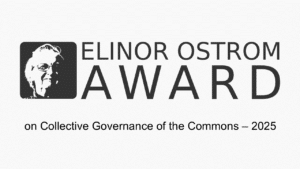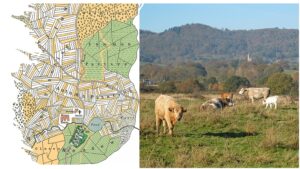In this post, IASC members Thomas Falk and Ilkhom Soliev and their colleagues share insights and reflections on their experiences from international development interventions in India. The focus is on better understanding the role of behavioral change for improved water governance and lessons for developing intervention strategies that can create desired impact at scale.
Why does behavior need to change in Indian water governance?
Across many parts of the globe, development scholars and practitioners deal with the challenge of facilitating change in water governance that can lead to more equitable and sustainable outcomes. International partnerships are formed and substantial donor funds are mobilized to improve water governance, yet the results are often disappointing, especially in the long run. The international academic community increasingly stresses that development interventions need to focus on lasting forms of change. This is a paramount challenge of development research and practice and here we report some of our reflections from our experiences in India.
India is globally the largest groundwater user and simultaneously among the world’s most water stressed countries (WRI 2016). Almost two thirds of the water requirement for irrigation and 85% of the domestic water use depends on groundwater (World Bank 2010). Trends in water abstraction will with high likelihood lead to water scarcity across many parts of India and affect most directly those depending on agriculture (NITI Ayog 2018). The growing competition over water resources can only be addressed by systemic changes towards sustainable water management. This requires understanding of the dynamics of water-related systems, including how sub-systems connect, properties that drive internal dynamics, and social structures and institutions that manage feedbacks and influence the direction in which the system moves (Abson et al. 2017). Diverse system actors create relations that drive the system’s directionality (Pahl-Wohstl et al. 2010). Within this network, actors take decisions that influence each other and create social, economic, and ecological system outcomes. We offer a behavioral perspective to system transformation and apply it to agricultural water management in India. For this purpose, we will first share a conceptual framework structuring our deliberations.
Conceptual framework for understanding behavioral change
We understand behavioral change as a long-lasting change in the way how people act which includes a general capacity of individual or collective actors to behave in a new way (Siebenhuner 2004). Looking at development processes through a behavioral lens places the network of actors into the center. We try to understand what drives the actors’ behavior and how we could effectively and efficiently influence it in a desirable way. This leads to the first key question:
Which actors need to change what behavior to support sustainable water management at scale?
There are different ways to answer this question. Actor analyses are part of the initial phases of most development projects. We recommend using diverse bodies of knowledge, allowing actors to formulate hypotheses about whose behavioral change is likely to bring about system changes. Once key actors are identified, the next question would be:
How could key actors be motivated or enabled to change their behavior in the desired way?
As development projects design intervention strategies, this question is often answered on the basis of implicit assumptions. In order to facilitate the clarification of such assumptions, we will dive a bit deeper into what drives human behavior. Thereby we apply the logic of methodological individualism and look at social interactions as the result of individual actions. By understanding individual actions better, we understand the way a system is changing better.
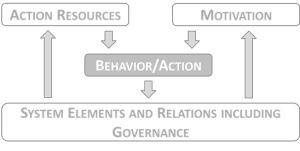
Figure 1 condenses our conceptual thinking about individual behavior. We consider three essential behavioral drivers: a) motivation, b) action resources, and c) governance, which influences the earlier two.
The motivation, as a behavioral driver, refers to important questions such as: “What do actors really want? What is their motivation, their interest?” Interest is one of the important dimensions in mapping stakeholders, yet it often remains very unclear to what the interest refers. We propose to ask what could motivate actors to take specific desirable actions. Reflecting on diverse types of human motivations can already help in questioning often-implicit assumptions about what drives actors. This in turn could direct us towards new innovative intervention strategies.
Human behavior is, however, not only driven by what people want but also by the existing capacities. We refer thereby to the concept of action resources as intangible and tangible assets that determine which actions an actor is able to take (Di Gregorio et al. 2012). The capital categorization of the Sustainable Livelihoods Framework illustrates how diverse action resources can be: a) financial capital, b) natural capital, c) physical capital, d) human capital, and social capital (Ellis 2000). Supporting behavioral change through interventions related to action resources could potentially ease constraints. A reflection on what action resources constrain an actor, as opposed to implicit assumptions, can potentially help to better understand what the critical bottlenecks are and how one could effectively support this actor to change behavior.
As people and organizations in a system interact, governance, as the third behavioral driver, can be understood as the processes through which these interactions are coordinated. An important dimension of governance is institutions, which are understood as the rules of the game. In their core, institutions are conditional incentives or disincentives. We highlight that these incentives or disincentives can work on the one hand on action resources, where they can broaden or limit the action resource base and thereby influence the actor’s action options. On the other hand, the institutions can influence the satisfaction of needs directly targeting the actors’ motivation system.
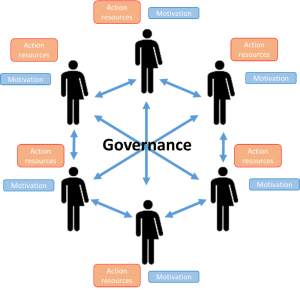
We started our reflection by acknowledging that diverse actors affect system outcomes. Understanding what drives the behavior of farm households, local leaders, businesses, researchers, and policymakers can be the starting point to change these behaviors strategically (Woltering et al. 2019). In addition, it will give us hints on how actors influence each other (Figure 2). How can one actor motivate or enable another actor to change behavior in a desirable way? Eventually chains of influence can emerge.
Developing theories of change for Indian agricultural water management
We applied this conceptual thinking to the case of agricultural water management in India. This process was supported by the CGIAR Research Program on Policies, Institutions, and Market (PIM), the Program on Water, Land, and Ecosystems (WLE) as well as the German Federal Ministry for Economic Cooperation and Development (BMZ). In February 2021, a team of Indian civil society representatives and international agricultural researchers held a workshop reflecting on a theory of change towards achieving more sustainable and equitable rural water use. More specifically, the workshop participants brainstormed on critical system actors, discussed what drives their actions, and how they can be influenced. The workshop outcomes were condensed and further discussed in iterative steps. In addition, we collected data on motivation and beliefs concerning two aforementioned actions from 37 farmers that collaborate with the civil society partner Foundation for Ecological Security. We present below some highlights of the reflection process.
Behavioral change in Indian agricultural water management
The workshop participants agreed that the overarching desirable outcome would be a more equitable and sustainable water use. Two specific actions stood out in this context:
- The choice of cropping systems taking water requirements into account is arguably the most important decision influencing consumptive water use sustainably and associated environmental externalities in India (Davis et al. 2018).
- Farmers’ individual contribution to the maintenance of common water infrastructure supports rainwater harvesting, sub-surface water recharge, and eventually increases the availability of supplementary irrigation for the community (Falk et al. 2020).
Crop-choice behavior
Farmers, as key actors, can support large-scale more equitable and sustainable water management by growing water efficient crops and thereby reduce the depletion of water resources (Figure 3). In the explorative farmer survey, generating income was identified as one of the main behavioral factors motivating farmers to take water requirements into account when making crop choices. Government’s current support mechanisms for farmers such as subsidies and special prices rather encourage intensive water use. Adjustments of government support programs in favor of water-efficient crops could provide incentives acting on farmers’ motivation. While increasing farmer’s income is also in the interest of the Department of Agriculture, officials seem to assume that this objective can best be achieved by increasing the water supply of farmers; a strategy that has its natural hydrological limits.
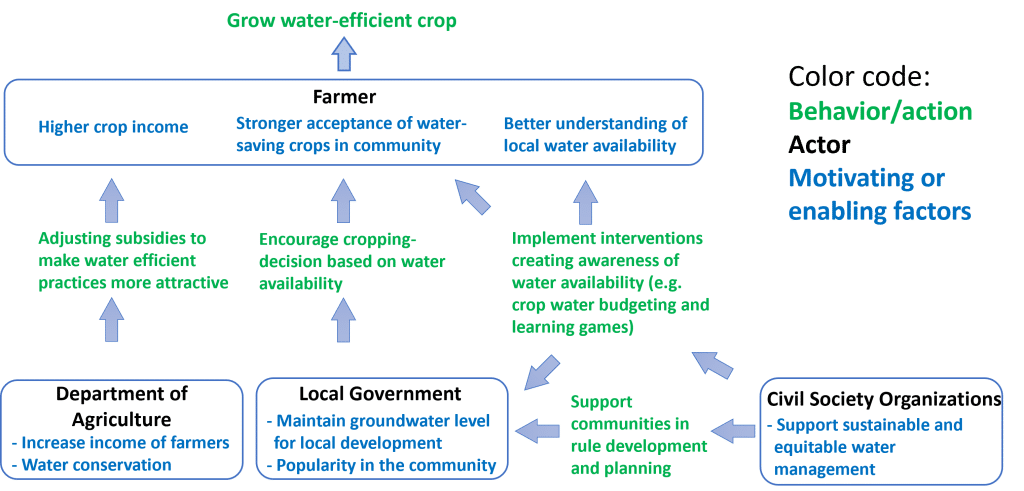
As another behavioral driver, workshop participants identified that farmers are often simply not aware that growing water consumptive crops leads to dropping groundwater tables and unequal distribution of water in the community. In this regard, civil society organizations (CSO) can play a critical role by helping in generating and transferring of knowledge. For example, CSOs can support communities in using tools such as crop water budgeting that can help farmers to better understand the local water availability, and create awareness that more efficient use of water enables more farmers to grow crops. This brings forward a specific social dilemma in communities. In some situations, it may be that a farmer could increase income or reduce production costs by growing a water-intensive crop. As water is scarce, this would, however, lead to a lower farming income at the community level. CSOs can create awareness for this dilemma, for example by using experiential learning games and in this way increase the acceptance of farmers to coordinate crop choices. Currently, there are strong norms according to which agricultural decisions are considered a very personal issue, which should not be of interest to others. If more farmers believe that community members and relatives approve growing water efficient crop-choices, a tipping point can be reached where cropping patterns change at large scale. An actor who could potentially influence such norms are formal and informal community leaders such as Panchayats. Working through leaders, CSOs can support communities in drafting and formulating water management rules.
Maintenance of commonly managed water infrastructure
Farmers’ individual contributions to the maintenance of common water infrastructure, especially water harvesting structures, can contribute to sustainable water management by increasing water availability (Figure 4).
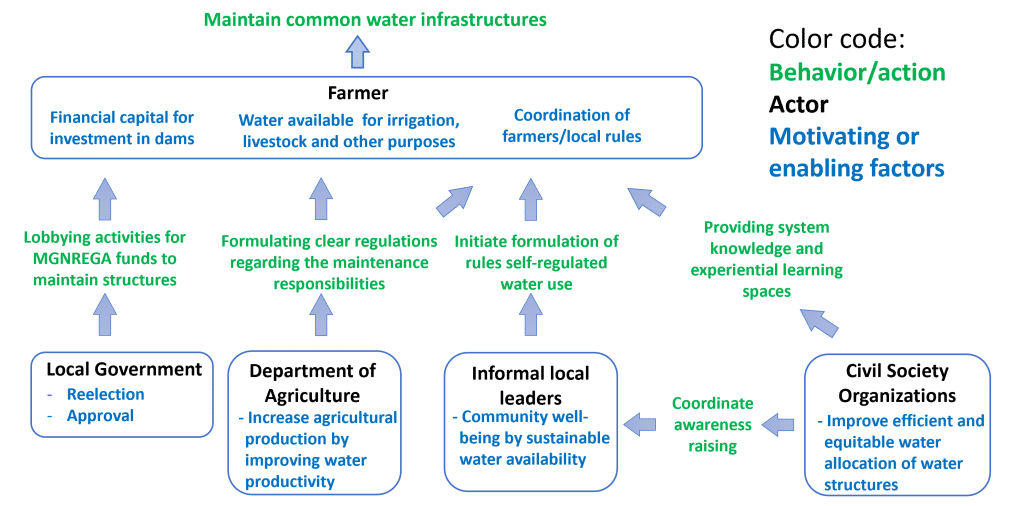
In general, the availability of water for diverse uses creates a strong interest of farmers in the functioning of the structures. In many parts of India, there have been century old traditions in jointly managing water harvesting. At the same time, such old institutions eroded as government increased its role in water management. There are anecdotal reports that some extension officers even discourage farmers to show initiative in maintenance activities. Transparent and effective government regulations clearly distributing responsibilities between government support programs and communities could be of mutual interest. This can improve agricultural productivity and increase the efficiency of public investments. The social employment scheme under the Mahatma Gandhi National Rural Employment Guarantee Act (MGNREGA) plays an important role in this regard. The scheme can be used for diverse community investments, and it is subject to the decision of communities and local leaders whether it is used for the maintenance of common water infrastructure. In this way, the scheme can ease a constraint of farmers, who frequently argue that they lack the required financial capital to keep infrastructure in good shape. Lobbying for a respective use of MGNREGA funds therefore corresponds to farmers’ needs and, if widely supported in the community, may even increase the popularity of the Panchayat.
At the same time, MGNREGA is unlikely to have the capacity and flexibility to fully ensure regular and timely maintenance of all common water infrastructure in India. As communities need to make own contributions it is important to acknowledge the presence of a social dilemma. While everybody using the infrastructure benefits, there are incentives to free ride on the maintenance activities of others – that is enjoying the benefits without making a contribution to support the system. This highlights again the need for coordination. In this context, workshop participants highlighted the role of informal leaders and their potential role in initiating the formulation of local rules. They can be supported for example by CSOs who facilitate experiential learning and participatory planning processes. Thus, informal local leaders and CSOs together can stimulate the coordination of farmers.
Conclusion
These two examples illustrate how reflecting on actors’ behavioral drivers can support the development of more effective intervention strategies. For instance, instead of responding to the widespread call for policy change, it becomes clear that some existing policies can be in line with more sustainable and equitable water use. A smarter policy implementation is required which could potentially be achieved by influencing behavioral drivers of mid-level officials. In addition, often it is assumed that farmers just need better knowledge to make more sustainable decisions. In the face of social dilemmas, this may be insufficient and coordination that involves change in the behavioral domain, where this is currently not well accepted, may be required. We also learned in the process how important it is to question assumptions. The civil society and academic participants of the workshop highlighted better knowledge and coordination as main behavioral drivers. The farmers in the interviews talked mainly about income and production costs. There may be links between these three factors and still, ignoring important motives of farmers may undermine the impact of interventions.
As a part of the above process of developing theories of change for Indian water management much more complex actor networks evolved than presented in these two examples. The question is how can one take advantage of what drives and motivates the individual behavior of each actor involved in the system of water governance? The exercise can be continued by asking how the motivational factors of influencing actors can best be addressed. It can be asked for instance who can best influence mid-level government officials and in which way. We hopefully gave an idea about how actor networks and chains of influence could be identified. This can form the basis for the development of intervention strategies that can effectively and efficiently create impact at large scale.
Thomas Falk1 2, Dennis Schüpf2, Wei Zhang3, Ilkhom Soliev4
1International Crops Research Institute for the Semi-Arid Tropics (ICRISAT), Program on Enabling System Transformation, Patancheru, India, t.falk[at]cgiar.org
2University of Marburg/Germany; Working Group Sustainable Use of Natural Resources, School of Business and Economics, Marburg, Germany, thomas.falk[at]wiwi.uni-marburg.de, dennis.schuepf[at]gmail.com
3International Food Policy Research Institute (IFPRI), Environment and Production Technology Division, Washington DC, USA, w.zhang[at]cgiar.org
4 Martin Luther University Halle-Wittenberg, Department of Agricultural, Environmental and Food Policy, Halle, Germany, ilkhom.soliev[at]landw.uni-halle.de, isoliev[at]daad-alumni.de




